In order to get the most strength out of my DIY CNC Router base I need to join the Bosch-Hexroth aluminum framing pieces by tapping them and then bolting them into the perpendicular pieces. The bolts will clamp the two pieces of extrusion together forming a strong mechanical bond. The only trick to this is that for a CNC machine you have to be very accurate with your drilling. And because the 45 x 90 extrusion has 2 bolt points, they have to be lined up near perfectly.
Instead of working with the final product I decided to work with a couple of scratch pieces and try out my theory. The pieces are about 8″ long which made them easy to clamp into the drill press. I imagine this will be more difficult when drilling the 16 holes in the 2 45 inch rails on the Y-axis of the router.
Since the holes through the center of the aluminum extrusion are 10mm, they are designed to be threaded at 12mm but none of the stock Bosch-Rexroth joining bolts they sold were what I wanted so I ordered some parts from Grainger.
I ordered the tap I needed for the bolts. The tap is a Self-Aligning High Carbon Steel (HCS) type 12mm x 1.75 pitch and cost about $9. I started with the easy bit first, tapping the two 10mm holes in the 45×90 Bosch-Hexroth extrusion.
I ordered some steel hex bolts from Grainger, they’re M12 x 1.75 x 50, that’s a 12mm diameter shaft with a 1.75mm thread pitch and a 50mm thread length. I ordered 50 bolts for $36 which was a decent price compared to what Bosch-Rexroth charges for their stuff, but I find most of that extrusion and connection hardware comes at a premium, so it’s best to buy surplus on eBay or elsewhere if you can.
The bolt heads are 18mm across and the T-slot is 10mm so I needed to bore an opening through the T-slot in order to get the bolt to seat inside of the T-slot. I clamped the extrusion to the drill press table with a C-clamp and then set a starter hole with a small drill bit as precisely as possible and then used a 1/2 inch drill bit to drill a hole with the drill press all the way through the extrusion and out the other T-slot. I needed to drill completely out the other side or the 12mm bolt would not fit completely though the material. I would have been better off with a 12mm bit but you use what you have. I’ll order a 12mm drill bit before working on the actual frame.
Additionally to fit the 18mm head of the bolt I needed to cut a larger hole through the top of the T-slots and also create a flat mating surface for the bolt head. As you can see in the 3rd picture above, the base of the T-Slot is at a 35 to 45 degree angle and the bolt would not seat well against that. I used a 3/4 inch Forstner with a lot of oil and a slow feed on the drill press to create that opening. I was surprised at how well the Forstner bit worked in aluminum, although the hole isn’t excellent quality, it’s still pretty good for a wood bit!
Once that minor machining process was done I could mount the two pieces together and see how things worked. The two pieces mated up together well and all was good. The bolt heads seated nicely into the flat spot that I had machined out with the Forstner bit, I’m feeling pretty good about this so far, but I’m going to talk to my buddy Ollie and see if he has any ideas about doing this as well to make sure there’s not a better option that what I did. I think I did alright for someone who doesn’t have a machinist workshop though!
4/1/2011: Things are continuing to move along. I’ve ordered some 4-inch by 3/4 raw bar stock aluminum from 8020 on eBay to make the end caps for rigiditiy, rather than using the Bosch-Rexroth extrusion. This CNC router will super-strong when complete. I also picked up some 1″ x 1/4″ aluminum bar stock for reinforcement. I am removing the extrusion from the ends of the long axis and I’m going to use solid 4 inch x .750 aluminum stock, it’ll work out great, you’ll see!
4/1/2011: I also just picked up the steel bar I need to mount the linear rails to the aluminum extrusions and I ordered the screws, taps, and drill bits from Grainger that I need to drill and tap the holes to bolt the linear rail in. The next step is to attach some screw drives, probably acme, to this unit. If you can recommend some places to get ACME screws and anti-backlash nuts from at an AWESOME price it would be greatly appreciate. I plan to use the ball screw I have for the Z, but the other two ball screws I have are two short, and I don’t believe I can afford ball screws for the X and Y axis 🙁 . You can put the URL right in your comment and I’ll move it to a URL section. Thanks so much for your assistance! (yes you, the reader!)
Previous: Assembling the Frame
Next: Changes and Progress
Search CNC Posts

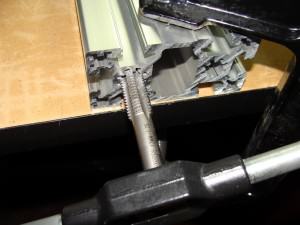
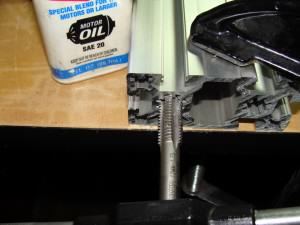
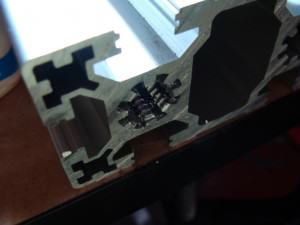
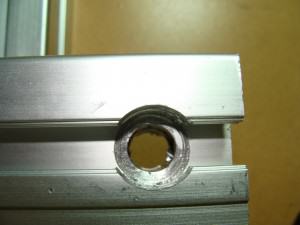
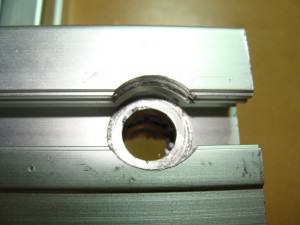
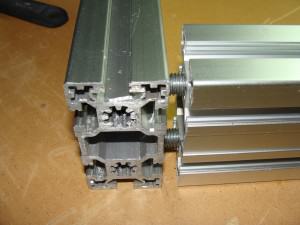
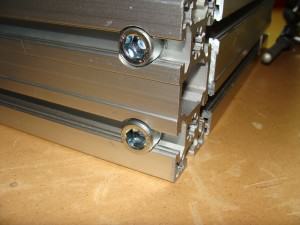
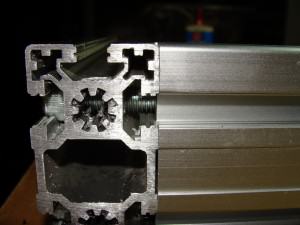
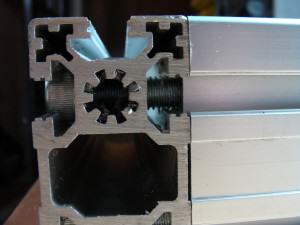
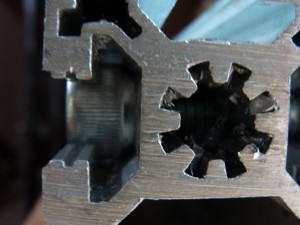
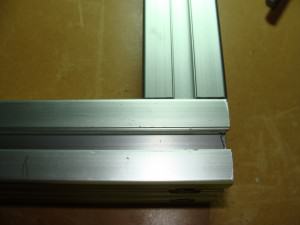
1 responses to Part 5: First DIY CNC Project – Drilling and Tapping Aluminum Extrusion
Just curious why you drilled and tapped the corner connections instead of using corner brackets?
Part 5: First DIY CNC Project – Drilling and Tapping Aluminum Extrusion 1 Trackbacks / Pingbacks
Part 4: First DIY CNC Project – Assembling the Frame | Jon's Hobbies Comment on Part 5: First DIY CNC Project – Drilling and Tapping Aluminum Extrusion (April 25th, 2011 at 22:13)
[…] build the Router, Linear Rails Arrival Part 4: DIY CNC Router Project – Assembling the Frame Part 5: First DIY CNC Project – Drilling and Tapping Aluminum Extrusion Part 6: First DIY CNC Project – Changes & Progress in Assembly AKPC_IDS += […]
Leave a reply to Part 5: First DIY CNC Project – Drilling and Tapping Aluminum Extrusion